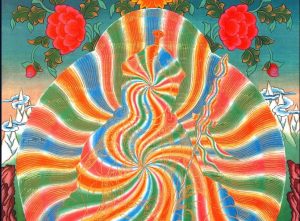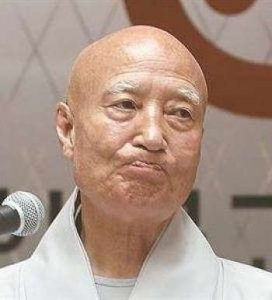
A finger pointing at the moon
The simple question of “What is a Buddha?” was raised in a casual discussion with a venerable Pure Land master in Vancouver. The group leader asked the participants to comment on this question before the master responded. The group was ready with their answers. After all, every Buddhist should have something to say on this vital topic, and most have enough information for a composite answer via Wikipedia or Google.
A Buddhist lady raised her hand and said, “A Buddha is an enlightened being who knows all truths about life and the universe. He has the ability to lead others to enlightenment.” Then the others expressed their opinions: he is omnipresent, omniscient, and omnipotent. He is the perfect embodiment of wisdom and compassion. He is non-duality and one with Nirvana.
It was time for the master—a true Buddhist scholar—to respond to this kindergarten-level question. Surprisingly, he hesitated then said, “It’s not an easy question to answer!” The participants were astonished; how could a knowledgable master find it difficult to answer such a basic, elementary question?
The master continued: “To be honest, with our limited capacities, we know almost nothing about the Buddha. Though there are many Buddhist scriptures telling us about the Buddha, these are like a finger pointing at the moon. All descriptions of a Buddha are just provisional definitions, which only refer to the finger. But actually, the Buddha is the moon.”
The Buddha, in his essence, is unknowable to sentient beings. We should utilize and respect the doctrinal statements about the Buddha that generations of Dharma masters have given us, but we should not treat them as a package within which the Buddha is somehow contained or limited.
A blind man exiting a dark room
Then the master said, “To use another analogy, a blind man or an ordinary deluded being cannot perceive that the room he is in. Our Saha world of suffering is dark. The lights are off and the blinds are drawn, but he has no way of knowing this state of affairs. But if he leaves the dark room by being embraced by Buddha’s light through name-recitation, he can feel the warmth of the sun or the Buddha’s light, even though he cannot see it.” He continued, “As we are ‘blind’ due to our heavy karmic obstructions, we cannot see Buddha’s light shining on us as we recite his name. However, this doesn’t mean that a Buddha is a mere projection of the imagination. He is always with us. We feel his warmth when we are cold; we experience his help when we are in need. His a living presence that transforms our lives for the better. These are facts, not fantasies or wishful thinking.”
The group was silent as they considered the master’s analogies. Then he said, “The answer to this question cannot be fully expressed in words. However, we can understand the Buddha if we can connect with him. Then, we will know the Buddha with our lives.”
What is meant by “knowing the Buddha with our life?” For instance, Amitabha, one of the most remarkable Buddhas, took five kalpas to formulate his great vows of deliverance for our sakes. He then cultivated immeasurable merits and virtues for countless eons. He created the Land of Bliss for us and accomplished his name, “Namo Amitabha Buddha,” so that we could recite it and attain rebirth. In order to understand a Buddha, it is better to connect with him directly with our lives rather than studying him academically.
The teacher appears when the student is ready
A Buddha is a teacher who appears when the student is ready. He is also a doctor for the sick patient. Amitabha Buddha, whose light is omnipresent and splendid, is a protector of those who are mindful of him when they are in danger. Moreover, Amitabha Buddha, thanks to his accomplishment of the 18th Vow, relieves us from suffering and can deliver us to his Pure Land at the end of our lives if we exclusively recite his name.
The Contemplation Sutra says, “Those who have envisioned them see all the Buddhas of the Ten Quarters. Because they see the Buddhas, this is called the Buddha-Recollection Samadhi. To attain this contemplation is to perceive the bodies of all the Buddhas. By perceiving these, one also realizes the Buddha’s mind. The Buddha’s mind is Great Compassion. It embraces sentient beings with unconditional benevolence.”
To eat, rather than analyze, a piece of bread
The master drew a final analogy to explain the matter. “Imagine a starving man who is given a piece of bread by a compassionate baker. This baker represents Amitabha Buddha. The starving man doesn’t hesitate for a moment and eats the bread. He doesn’t stop to think about truth or falsehood; he only knows that he is dying of hunger, and the bread will sustain his life. After eating it, he immediately begins to feel better.
“A man who is not starving might instead inquire into the baker’s reputation, analyze the ingredients of the bread, the amount of yeast used and the method of baking. He might compile volumes of data and write scholarly articles comparing and contrasting the piece of bread in question with other types of bread. He might produce a documentary film on the topic of baking, but he will never understand bread until he simply eats the slice before him. When you eat a piece of bread, you realize the entire meaning of a slice of bread without uttering a word.”
Similarly, we cannot answer the question of what a Buddha is with humanity’s discursive, conceptual, and dualistic languages. However, we will know the full and complete answer once we are reborn in the Land of Bliss, Amitabha Buddha’s realm of unconditioned Nirvana.











